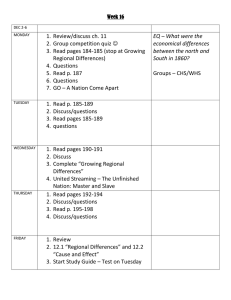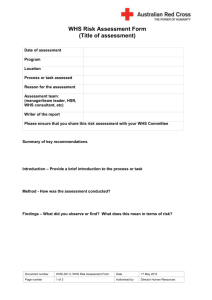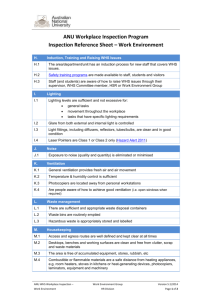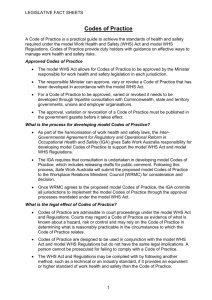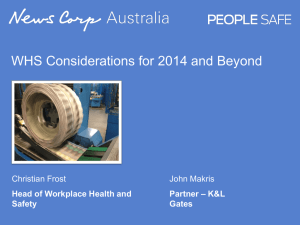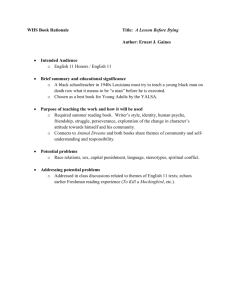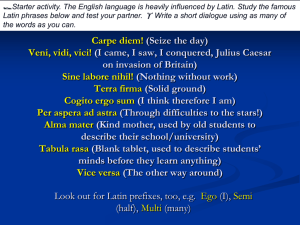THE HADRIAN’S WALL WORLD HERITAGE SITE MANAGEMENT PLAN CONSULTATION, 2014
advertisement
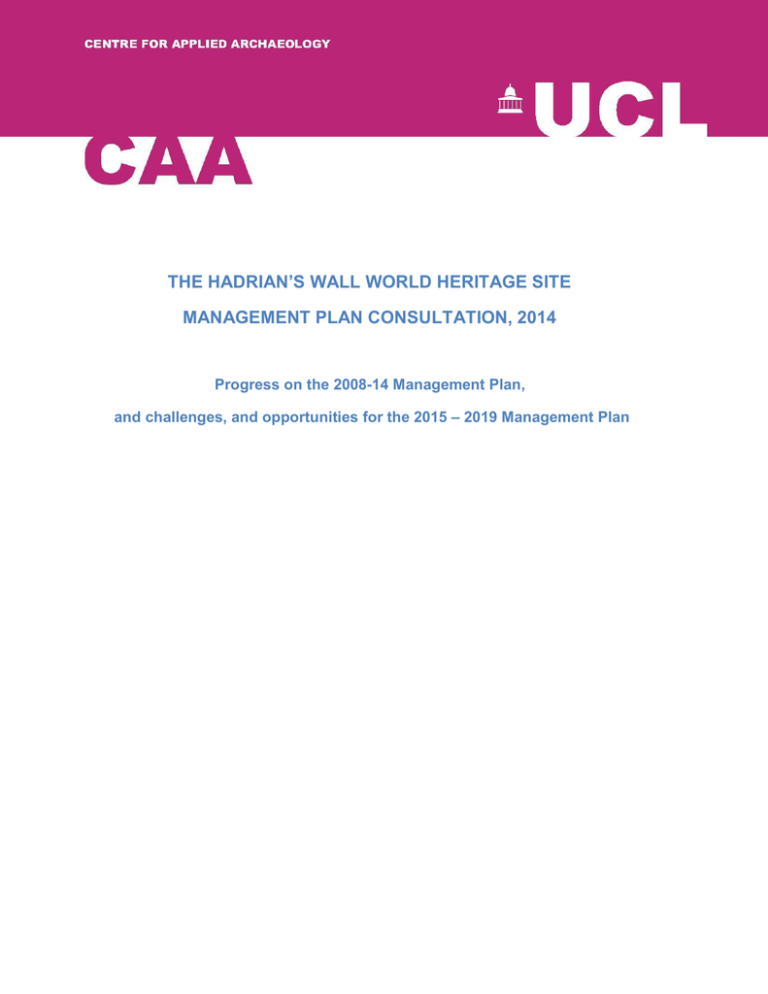
THE HADRIAN’S WALL WORLD HERITAGE SITE MANAGEMENT PLAN CONSULTATION, 2014 Progress on the 2008-14 Management Plan, and challenges, and opportunities for the 2015 – 2019 Management Plan CONTENTS MANAGING THE WORLD HERITAGE SITE Issue 1: Management of the WHS IDENTIFYING THE WORLD HERITAGE SITE Issue 2: The boundaries of the World Heritage Site PROTECTING THE WORLD HERITAGE SITE Issue 3 Legislative provision Issue 4 Protection in urban areas Issue 5 Metal detecting Issue 6 Risk preparedness and disaster management CONSERVING THE WORLD HERITAGE SITE Issue 7 Conservation of archaeological monuments and sites Issue 8 Rural land management Issue 9 Research PRESENTING, ENJOYING AND TRANSMITTING KNOWLEDGE OF THE WORLD HERITAGE SITE Issue 10 Sustainable physical access Issue 11 Developing the visitors’ experience and understanding of the World Heritage Site and Buffer Zone Issue 12 Sustainable development and economic regeneration Issue 13 Engaging with communities Issue 14 Marketing the World Heritage Site Issue 15 Education MANAGING THE WORLD HERITAGE SITE Issue 1: Management of the WHS Awareness of UNESCO World Heritage values (Policy 1a) There has been little coordinated progress in raising awareness of the concept of World Heritage and of UNESCO aspirations, aims and objectives. Some specific achievements have created a platform for more coordinated work in the future, including: identification of UNESCO aspirations as a theme of the Interpretation Framework and in the Learning Strategy explicit promotion of UNESCO aspirations and values through the Living Wall element of the new Roman Frontier Gallery at Tullie House agreement between the three northern UK WHSs of Hadrian’s Wall FRE, Durham, and Fountains, which have agreed to work together to promote UNESCO aspirations and the UNESCO World Heritage in Young Hands Education strategy. Inscription as Frontiers of the Roman Empire WHS: implications and opportunities (Policy 1b) International collaboration across the Frontiers of the Roman Empire WHS has been positive and effective: The Hexham Group brings together those responsible for managing those parts of the FRE currently included in the WHS. Through the Bratislava Group and specific initiatives such as Limes Tourism Connect there is a wider collaborative network across the FRE. Contributions by FRE partners at the annual conference have been welcomed There has been effective sharing of good practice between FRE partners on issues including archaeology in urban areas, interpretation, signage and presentation, and management plans. An overall conservation framework and values-based management (Policy 1c) There has been no progress in developing an integrated conservation framework for the WHS. Preparation of the next Management Plan (Policies 1d, 1e) Research and data analysis to form a basis for the next plan has been carried out: A basic database of ownership along the National Trail: established and maintained. Basic Open Source GIS: established but not fully implemented due to lack of resource Audience research: undertaken to inform development of the Interpretation Framework On-going collection of visitor statistics, monitoring of bus users The intention is that the new Management Plan will be online, and multi-layered to accommodate levels of detail. There will be a degree of interactivity to allow updating during the Management Plan period. The Management Plan Committee and Interest Groups (Policies 1f, 1g) There has been some success in improving representation on the Management Plan Committee with increased participation from businesses, farmers and local authorities. Attendance however is variable. Members/partners consistently recommend use of web based resources to facilitate engagement and interaction with the Management Plan. There is also the ongoing issue that for most partners the WHS and the Management Plan are not a strategic priority. Partners need to see how activity will be of benefit to and help progress their own strategic priorities, and to take responsibility for input into site management/projects. The Interest Group approach has had mixed success with regard to participation, and levels of activity. The Antonine Wall’s approach has been to develop a number of working groups that will focus on particular aspects of delivering the new plan, rather than broader interest groups. There has been little progress on developing monitoring indicators by which progress on implementing the Management Plan can be measured. Reporting (Policy 1h) Action Plans are available through the Hadrian’s Wall Country website and through the Management Plan Committee meetings, and are regularly updated. There is an annual report and review of the Hadrian’s Wall Conference. Subsequent developments Following the recent national economic crisis, the demise of the Regional Development Agencies, and a severe reduction in funding, Hadrian’s Wall Heritage Ltd has become a charitable Trust (Hadrian’s Wall Trust) with the core objectives of working with the Management Plan Committee to coordinate and help to raise funds to deliver all aspects of managing the WHS (conservation, understanding, sustainable development) through a holistic and integrated approach. IDENTIFYING THE WORLD HERITAGE SITE Issue 2: The boundaries of the World Heritage Site Clarification and definition of existing boundaries (Policies 2a, 2b) Definitive maps and a database of the component parts of the WHS were formally adopted by UNESCO in July 2012, providing clarification of the area of the WHS. Proposed extensions to the World Heritage Site (Policies 2c-2f) Developer funded excavation has enabled significant progress in defining the line of Hadrian’s Wall in Tyne and Wear. The aspiration to address the issue of unrevised schedulings in Tyne and Wear and Carlisle and other recently discovered remains has not been fulfilled... (See Policies 3g, 3h) In future, simple boundary changes (for instance the inclusion of non-scheduled linear elements of the frontier) are likely to be able to be accommodated within the WHS without full renomination, as long as such changes do not represent changes to the OUV as clarified in the recent submission to UNESCO. More substantial changes, such as the inclusion of the Roman town at Carlisle, would be much harder to achieve. The Buffer Zone (Policy 2g) There is no issue at this point with the boundaries of the Buffer Zone, and no change to the policy is proposed. Subsequent developments A SOUV (Statement of Outstanding Universal Value) is the definition of what is significant about a World Heritage Site (WHS). There is a UNESCO requirement for all Sites currently without such a statement to agree one retrospectively. Although this was not an issue at the start of the current plan period since Hadrian’s Wall already had a SOUV as an individual WHS, the expansion of Hadrian’s Wall into the Frontiers of the Roman Empire WHS means that UNESCO has requested development of a retrospective, overarching SOUV for the whole of the Frontiers of the Roman Empire WHS. An initial submission in 2012 was rejected by UNESCO as both incomplete and too long, and discussions to resolve this issue continue: the Intergovernmental Committee (IGC) for the FRE WHS has accepted a working proposal that there should be one SOUV for the whole FRE WHS supported by attribute statements for each of the component parts. These attribute statements would be an additional guide to local decision makers. This proposal has been accepted in principle by the Bratislava Group (made up of site cocoordinators of those countries which have already declared their intention to nominate their stretches of the Roman frontier as a World Heritage Site, and part of the FRE). Further discussions will need to take place during the period of the new plan in order to achieve a single SOUV for the FRE. PROTECTING THE WORLD HERITAGE SITE Issues 3 (Legislative provision) and 4 (Protection in urban areas) Legislative reform affecting heritage protection (Policies 3a, 3b, 3c) The current Management Plan period has witnessed significant changes in planning policy, especially the introduction of the National Planning Policy Framework and its dramatic slimming down of planning guidelines. Planning authorities are still exploring the implications of this change; however, it is aimed to be as robust, in terms of its treatment of the historic environment, as previous regimes. Local authority planning policies (Policies 3d, 3e, 3f) Many local authorities are reviewing their local planning frameworks, which refer to status of the WHS and of the Buffer Zone. Understanding of Outstanding Universal Value and Buffer Zones amongst local authority partners/Local Policy Frameworks needs strengthening, with increased dissemination of the status and geographical implications and reach of the WHS. Roman military sites not currently protected through scheduling (Policies 3g, 3h) The scheduled areas along Hadrian’s Wall constitute the designated WHS. Modern techniques and the opportunities for excavation presented by development have provided significant new information. The current Plan included an aspiration to review existing schedulings, and look at whether protection by designation would be appropriate for new discoveries. Resources were not available to allow this issue to be addressed, leaving remains that should logically be a part of the WHS outside the scheduling designation. Reconciling different legislation (Policy 3i) There has been no specific activity, although it needs to be noted that Natural England, the body responsible for all SSSI's along the WHS, have continued to fund very significant amounts of conservation work on the historic environment. Some work, particularly with reference to SSSI’s and National Nature Reserves has been done on an informal basis, after discussions at the Conservation, Farming and Land Management Interest Group. Northumberland National Park Authority have sought and received comment from English Heritage on their draft management plan for the Greenlee Lough National Nature Reserve. Protection in the urban areas (Policies 4a, 4b, 4c, 4d, 4e, 4f) Local authorities should be encouraged to further protect or enhance non-scheduled elements that contribute to the Outstanding Universal Value of the WHS. Although all local authorities agree in principle that they should not permit new development on currently open land on the line of the Wall, there are some difficulties in applying this where the line of the Wall is not accurately known, primarily in urban areas. (See also Policy 1d) Agreement of a common template will make it easier to require developers to provide appropriate interpretive signage. (See Policy 11g) The profile of the WHS in urban areas generally needs to be raised, to aid protection. Issue 5 (Metal detecting) Current protection/ The Portable Antiquities Scheme/ Monitoring and metal detecting/ Guidelines (Policy 5a) Cases of illicit metal detecting have been few but they have the potential to be damaging to the World Heritage Site. The ability to police such a large and open monument is challenging; partnership working and shared understanding have been the best methods of reducing the impact, but more work is needed in understanding these impacts. Further active engagement and communication with all parties concerned would ensure that the law is better understood by both detectorists and landowners. Relations have been developed with the metal detecting community, via the Portable Antiquities Scheme and its local Finds Liaison Officers. Issue 6 (Risk Preparedness and Disaster Management) Contagious livestock diseases (Policy 6a) The 2001 Foot and Mouth epidemic showed the potential limitations of disaster planning and the need to think laterally about potential disaster risks. No progress in this area. Mitigation of risks (Policies 6b, 6c, 6d) The challenge of climate change is increasingly significant through both direct (changes in weather) and indirect (vulnerability to visitor pressure) impacts. There has been no progress in developing a co-ordinated, proactive approach to assessing climate change impacts and mitigation. Emergency planning has been identified as an issue to be addressed through the Planning and Protection Group. Managing communications is an important means of managing visitors, and thereby mitigating the risks they pose to the World Heritage Site. Communication is the first stage of a risk management process which consists of four hierarchical stages of avoidance (elimination of risk), reduction (mitigation of risk), sharing (dispersing risk) and retention (direct interventions). Risk mitigation for disaster planning is covered by Local Resilience Fora which operate on the basis of maintaining a database of key contacts, rather than detailed plans in document form. The English Heritage Inspector of Monuments for Hadrian’s Wall has been identified as the key contact. CONSERVING THE WORLD HERITAGE SITE Issue 7 Conservation of archaeological monuments and sites Exposed masonry, and the Clayton Wall (Policies 7a, 7b) The National Trust SMR is now up and running, and a monitoring programme is underway with help from NT volunteers. Repair works have been carried out to parts of the Clayton Wall in the central section. In order to discourage visitors from walking on the wall, there has been an ongoing campaign of awareness-raising information, and creation of signage. Archaeological earthworks (Policy 7c) Implementing and monitoring management regimes on archaeological earthwork sites that are prone to erosion are ongoing priorities, but only moderate progress has been made. Areas on the Heritage at Risk Register (Policy 7d) Several areas of Hadrian’s Wall have been on the Heritage at Risk Register produced by English Heritage. Works through Higher Level Stewardship have tackled a significant area at Great Chesters and a number of the smaller areas during the period of the current Management Plan. As a result of a £500,000 SITA Trust1 grant, three sites (Burtholme Beck, Great Chesters and Port Carlisle) identified in the current plan as priorities will be removed from the Register. 1 Environmental body that operates under the Landfill Communities Fund distributing funds contributed by the recycling and resource management company SITA UK. There are opportunities to identify and prioritise issues and marry these with other funding agendas and opportunities. (e.g. community engagement, skills and employment development) Causes of damage (Policy 7e) No progress has been made in controlling the activities of burrowing animals in the WHS where they impact on significant archaeological remains. Generic consents (Policy 7f) There is an ongoing creation of generic consents and Heritage Partnership agreements, with some considerable progress achieved. Research and publication (Policy 7g) The SITA programme is being developed in accordance with appropriate research and guidance. Assessment and monitoring (Policies, 7h, 7i) Better understanding of the condition of the monument can be achieved by bringing together data sets from a variety of sources to enable clearer understanding of cause and effect. English Heritage has made a proposal to commission a Condition Survey of the monument. No progress has been made in reviewing and reassessing the methodologies proposed in the Raphael project manual, and the work undertaken in the project period: there is an opportunity to include some aspects of this within the Condition Survey to be commissioned by English Heritage. Hadrian’s Wall Trust intends developing a volunteer based monitoring system during 2014, and there is wide potential for engaging visitors with protection and conservation of the WHS also through community archaeology and voluntary giving. Fixed-point photographic monitoring of key views has not been progressed. Subsequent developments Recent and planned improvements in the quality of visitor facilities and infrastructure make it likely that visitor numbers will increase over the next few years if supported by effective marketing. The spread of these improvements across the World Heritage Site as a whole creates opportunities to raise visitor awareness of currently less visited sectors, thereby spreading visitor pressure on particular parts of the WHS. Issue 8 Rural land management Protecting the WHS by assisting farming (Policy 8a) A large proportion of farms along the Hadrian’s Wall corridor are in the Higher Level Stewardship Scheme, bringing improvements to a number of sites, especially Hotbank Farm, Lanerton Farm and Cawfields. Significant work has been done to improve both the fabric of the monument and the surrounding landscape to the benefit of the farming community and visitors. The cumulative effect of this investment into the corridor has been immense and needs to be supported through the current period of reform of the Common Agricultural Policy. The future priorities of stewardship are uncertain and need to be kept under review. Pasture and stock farming (Policy 8b) Although key sites at risk have been identified under the SITA programme, there is still a need to establish a mechanism for monitoring sites identified as being at risk from ploughing and apply appropriate solutions in cooperation with farmers. The proposed condition survey by English Heritage, and the volunteer monitoring programme proposed by Hadrian’s Wall Trust should contribute to this. Engaging with farmers continues to be a challenge although there have been several instances such as Lanerton and Great Chesters where positive relationships have been developed to resolve particular conservation and management issues. Farmers and landowners currently do not have an adequate voice in managing the World Heritage Site. Solutions need to reflect the reality that farmers are individuals, and not necessarily a coordinated community, and that farms operate under very individual circumstances. Forestry and woodland (Policy 8c) The Forestry Commission’s Forest Services have implemented several initiatives in response to the aspiration in the current plan to encourage planting of broadleaved native species only, within the Buffer Zone. Clearance of an area of woodland on the line of the Wall at Cockmount Plantation to mitigate against windblow and root damage is being undertaken through the SITA project (see Issue 7). Managing the landscape to protect archaeological and natural values (Policy 8d) The creation and implementation of individual management plans that take into account the needs of both the historic and natural environments for each SSSI is part of ongoing practice by Natural England. There is still a need to identify and implement the necessary processes to develop a wider landscape strategy appropriate for the WHS (see Policy 1c) Issue 9 Research The Archaeological Research Framework (Policy 9a) There has been a healthy programme of field research over the current plan period. This field research has included: excavations at Vindolanda, Arbeia, Maryport and Ravenglass Wall Quest: a major Heritage Lottery funded community archaeology project in the east (Arbeia to Corbridge) managed by Tyne and Wear Archives and Museums (TWAM) excavations on sites associated with the frontier garrison although not part of the WHS, at Binchester and Papcastle: these have also contributed to understanding of the frontier. developer funded archaeological fieldwork on Tyneside, which has produced significant progress has also been made in understanding the line and nature of the monument in urban areas. Following a feasibility study conducted by OA Digital and advised by a steering group with representatives from English Heritage and Natural England, Hadrian’s Wall Trust has installed an open source GIS package that provides a basic level of functionality. The system has full compatibility with the ArcGIS and Mapinfo systems used by most partners and could be expanded to include detailed archaeological data. The Newcastle University Digital Humanities project has been set up to further review and develop ideas for a Wall-wide GIS. English Heritage has issued Hadrian’s Wall Trust a contractor’s licence document for the OS Base Maps / Map Tiles at 1:10,000 scale. HWT has not subsequently had the resource to make effective use of the system. Further work is needed to identify the precise course of the Wall and the boundaries of its installations using all appropriate techniques, including a complete set of geophysical surveys for the principal Wall and Stanegate sites. The Research Framework is widely accepted as an important guide to research priorities, but needs to be monitored as to its real influence and effect. Research Coordination and funding (Policy 9b) An annual forum has been set up through the Archaeological Research Interest Group. Research funding continues to be sought on an individual organisational basis. Ongoing and future archaeological research (Policies 9c, 9d, 9e) Archaeological investigation and excavation follow principles and guidance set out in the Research Framework, and the Standard guidance and basic requirements for SMC. In parallel with the publication of the Research Framework there has been some geophysical survey. Geophysics has been less actively used as a research tool in the current plan period than previously, as most major sites have now been examined using at least one geophysical technique. More recently, Lidar remote sensing technology, aerial photography and field survey have been highly effective in helping to identify new sites. Wider research (Policy 9f) Whilst progress with archaeological research has been generally good there has been no progress in developing a broader research framework for the World Heritage Site incorporating the natural, historic and present landscapes and their use by visitors and local people. The Archaeological resource (Policy 9g, 9h) In each of the last few years, survey work has been showcased by the Archaeological Research Interest Group: at their annual Archaeology Forum; in the publication of an annual review of research activity, and at the annual Hadrian’s Wall WHS conference. There are opportunities for engagement of visitors and local volunteers in excavations at South Shields, Vindolanda, Ravenglass and Roman Maryport, and perhaps linked opportunities for Heritage Lottery Fund (and other) funded research projects that engage local people while forwarding the Research Framework. PRESENTING, ENJOYING AND TRANSMITTING KNOWLEDGE OF THE WORLD HERITAGE SITE Issue 10 Sustainable physical access Hadrian’s Wall Country bus (Policies 10a, 10b) The AD122 bus service has been reviewed and improved year on year. User numbers and revenues have increased by 40% over the Plan period since 2008 to around 50,000 per annum. A new bus contract has been issued with new rolling stock now operating along the Cumbrian part of the route. Two out of three buses are new. Generally, satisfaction with the service is high. However, annual uncertainty over funding leads to last minute negotiations to close the gap, delays in confirming the timetable and consequent delays in publishing and advertising at the start of the season. Alternative business models/sources of funding need to be explored. Train and bus schedules have been integrated where possible. Further work is needed, and proposals for 2014 focus on the use of Brampton and Hexham as Hadrian’s Wall hubs linked to other bus and rail services. Coach services (Policy 10c) Coach operators were included in audience research for the Interpretation Framework, and a coach operators’ feasibility study was undertaken by Hadrian’s Wall Trust in 2011. Improved route information is to be included on the Hadrian’s Wall Country website. Rail services (Policy 10d) Train and bus integration has improved with the branding of the Newcastle/Carlisle line as the Hadrian’s Wall Country Line, the creation of a branded platform and information point on Carlisle station for the Hadrian’s Wall Country and Settle/Carlisle lines, and improved linkage between timetables. Discussions are underway with NEXUS, Newcastle City and others to raise the profile of transport connections with the WHS at Newcastle Central Station. There is an in principle agreement from the National Rail Authority to re-open Gilsland station: funding is being sought by the local community. Further integration with other modes of transport is needed. Walking: the National Trail and beyond (Policies 10e, 10f, 10g, 10h) End-to-end walkers on the National Trail have increased in numbers by over 65% since 2006, to 12,000. The Hadrian’s Wall Path was voted England’s favourite National Trail by viewers of Countryfile Magazine in 2011. An estimated 500,000 people walk a section of the National Trail each year, contributing over £180 million to the economy of the north of England. One of the major success stories of the current Plan period has been the resolving of many of the critical site-specific Trail issues faced in 2006, the condition of the Trail improving 27% since 2006 at the same time as user numbers increased. Monitoring and reaction to problems however are critical. It is important to find ways to encourage the increasing numbers of walkers to use a wider range of paths, linked to the National Trail. The financial resources of the Rights of Way authorities continue to be severely stretched. They provide support through time spent in assisting with the management of the Trail by RoW staff and through small cash contributions. Following the National Trails funding review, from 2014 the LAs are formal partners in the National Trail Partnership responsible for managing the Trail and will be contributing to its maintenance. Funding has been reduced. The full impact of this will need to be assessed but it is likely additional funds will need to be found. Research into techniques and materials for the maintenance of the grass sward on the Trail continues: 'Grassform' reinforcing sheet has been piloted on gradients in Cumbria. The increasing number of challenge and charity walks involving large numbers of walkers is causing concern, and active conservation messaging is needed to address this. Organisers are encouraged to seek advice from Hadrian’s Wall Trust. The summer passport continues to be promoted and has been updated twice during the plan period to date. The “Essential Companion” needs updating for 2014. Future use of web-based formats could reduce costs of producing new editions. “Every Footstep Counts” was updated and included in the circular walks booklet published by HWT. It is also available on the website, and is being actively promoted in 2013 and 2014 in nationwide television and radio campaigns. A code of practice has been developed. A series of alternative walks linked to the National Trail has been published by Hadrian’s Wall Trust and disseminated for public consumption. Several of these routes are patrolled and monitored by volunteer rangers, managed by HWT. The Coastal Path initiative being taken forward by Natural England is an opportunity to raise the profile of the World Heritage Site and improve walking opportunities down the Cumbrian coast by effectively extending the National Trail down the coast south of Bowness. This could be branded as Hadrian’s Coast Path. Cycling: Hadrian’s Cycleway and beyond (Policy 10i) An off-road section alongside the B5300 between Maryport and Allonby has been created (at a cost of £670k) An electric cycle network and hire scheme has been set up along the Cumbrian part of the WHS (Ravenglass to Brampton). New cycling booklets and improved signage will also be delivered. Haltwhistle has been established as a Cycle Hub with 7 new way-marked routes. Saddle Skedaddle (cycling business) reports significant growth in cycling tourism linked to the Hadrian’s Cycleway. Car access (Policy 10j) No progress has been made on reviewing car park charging policies, provision and usage across the WHS and making recommendations for improvements, including the potential provision of park-and-ride facilities. There is continuing concern over the speed of traffic along the B6318 (Military Road). The Northumberland National Park Authority has agreed to discuss these issues with the Highways Authorities as part of the Sill Project2. 2 £11.2 million project to create a Landscape Discovery Centre and new YHA Youth Hostel at Once Brewed http://www.thesill.org.uk/ Signage (Policy 10k) Proposals have been produced to improve signage of the WHS from major roads. The proposals include the creation of two scenic tourist routes across the WHS; one along the Military Road (B6318) and the other along the Cumbrian coast. A Cumbrian route between Carlisle and Maryport is being implemented through the RDPE programme. Concerns have been raised by some partners about the proposals for the route along the Military Road, and the non-inclusion of the eastern end of the Site, which need further discussion and agreement. Strategic development and resources (Policy 10l) Northumberland National Park Authority is piloting electric vehicles in rural areas. Charging points for electric cars have been established across the WHS by Bowness Renewables. The transport strategy published in 1999 has not been reviewed, a task that is now overdue. Widening access (Policy 10m) Site and museum managers regularly review Disability Discrimination Act (DDA) compliance as part of their business and operational planning. New galleries have been designed to be accessible under DDA guidance. There are, however, limited opportunities for inclusive access across the WHS landscape. An easy access path has recently been completed at Steel Rigg, and ladder stiles at Peel Crags and Catstairs have been replaced with gates. There have also been improvements to the Military Way path west of Housesteads. Issue 11 Developing the visitors’ experience and understanding of the World Heritage Site and Buffer Zone Investment at the main WHS visitor attractions (Policies 11a, 11b, 11c, 11d) Major new galleries opened in 2010 at the Great North Museum, in 2011 at Vindolanda, the Roman Army Museum and Tullie House. Facilities at Housesteads were significantly upgraded in 2012 (new museum) and 2013 (upgraded visitor centre). Planned investment: An initiative has been developed by Tyne and Wear Archives and Museums, Hadrian’s Wall Trust, and local authorities on Tyneside (Newcastle City Council, North and South Tyneside) linking Arbeia, Segedunum and the Great North Museum. The project envisages refurbishment of facilities at Arbeia and Segedunum, the development of a virtual tour of the WHS through the urban area and an alternative route to the National Trail through the city. Further major development is proposed at Maryport. Refreshment of the offer at Birdoswald would significantly enhance the visitor offer in Cumbria and assist in dispersal of visitors. Recent and future investment creates an opportunity to encourage visitors to the eastern and western parts of the WHS where there is poor awareness of what is available amongst both visitors and local people. The total investment represents approx £12 million. This has produced a significantly improved family and wet weather offer. Sites in the Visitor Quality Assurance Scheme (VAQAS): Roman Arbeia, Segedunum, the Great North Museum, Housesteads, Vindolanda, the Roman Army Museum, Birdoswald, Carlisle Castle, Tullie House. Sites not in the scheme: Corbridge, Chesters, Senhouse Museum. Investment in interpretation at sites in the vicinity of the WHS (Policy 11e) Proposals for a major new development at the Sill (Northumberland National Park Authority) Walby Farm Park on the line of the Wall east of Carlisle has created a high quality attraction aimed at younger children with potential to develop more interpretation and learning resources for children and adults. This was voted National Farm Attraction of the Year 2010. Investment at Lanercost and at Vallum has created high quality tea rooms and local produce centres which also serve as WHS information points. Other WHS information points have been created in partnership with local businesses and communities including Ravenglass and Eskdale Railway, Bank Mill Nursery, Bewcastle church, the Red Lion at Newbrough, and the Errington Arms. Significant developments have been undertaken along the Solway as a result of partnership projects between Solway Coast AONB and Hadrian’s Wall Trust. These include Holme Cultrum Abbey Interpretation Centre, the Wetland Interpretation Centre and numerous interpretation points. The WHS and Solway AONB are now jointly signed. New interpretation has been facilitated by Hadrian’s Wall Trust at St Bees. Feasibility studies managed by Hadrian’s Wall Trust have been completed or are in hand for Bowness (visitor centre and business premises), LYC House, Longtown Memorial Hall, and Brampton Moot Hall. Interpretation (Policies 11f, 11g) The Plan period has seen the development and publication of an Interpretation Framework for Hadrian’s Wall with wide-ranging ideas through which to enhance public understanding of the monument, its landscape and broader cultural heritage. It has had a mixed reception. English Heritage has raised concerns that the Framework addresses many issues that lie outside of the Outstanding Universal Value of the WHS. Internationally (including both Antonine Wall and German Limes partners) it is seen as an example of good practice in interpretation planning for complex heritage sites, and its approach is being adopted along the German Limes in Bavaria. Using approaches advocated in the Framework, the Roman Frontier Gallery in Tullie House has received excellent reviews in the Museums Journal and from visitors. Websites and other digital media provide potential practical tools for heritage interpretation, and this should be a major feature of the new Plan. The www.visithadrianswall.co website has been redesigned to create a flexible platform for future development, supported by use of social media including Twitter and Facebook feeds. The www.romanfrontier.eu website provides a complementary platform for communication about the wider Limes from Scotland to Hungary. The Plan period has seen a series of major events engaging wider audiences with the WHS (Garrisoning the Frontier, Illuminating Hadrian’s Wall, Connecting Light, and the Jubilee Beacon). Also, a number of smaller scale events, such as Singing in the Bath, Bards in the Bar and the Poetry Picnic held at Thirlwall Castle, delivered by the Hadrian Arts Trust and the ambitious programme of re-enactment events organised by English Heritage. 30 new or replacement information/interpretation points have been installed, from Ravenglass to Wallsend. An appraisal carried out by Frontiers of the Roman Empire colleagues in Germany and presented to the 2014 conference revealed that compared with the Upper German/Raetian Limes, information signage across the Hadrian’s Wall WHS is nevertheless poor. At many locations it is difficult for the visitor to appreciate that the site or location they are at is part of the WHS. Agreement of a common template for signage will improve interpretation, and make it easier to require developers to provide appropriate interpretive signage. The new suite of signage across the Cumbrian part of the WHS implemented through the RDPE programme follows a common design template: need to explore with partners the opportunity to use of this template more widely. Engaging visitors and local people in management (Policy 11h) There are opportunities to engage visitors and local volunteers with protection and conservation of the WHS through condition monitoring, audience research, etc. (See also Policy 13a) Reconstruction (Policies 11i,11j,11k) No formal proposals for physical reconstruction on the WHS or in the Buffer Zone have been brought forward during the plan period. The virtual reconstructions used in the new Eagles Eye film at Vindolanda and in the new video at Housesteads have been well researched and have received excellent reviews from visitors. The high standards of virtual reconstruction set by German FRE partners have stimulated interest and discussion on the use of virtual imagery including development of mobile apps. Issue 12 Sustainable development and economic regeneration Cooperative working between regional, sub-regional and local organisations (Policy 12a) Partnership activity across the WHS includes attractions, Local Authorities, governmental organisations, businesses and communities. Activity includes destination marketing, capital investment and supporting local businesses e.g. via the Cumbrian RDPE programme partnership working amongst local authorities on Tyneside the Hadrian's Wall Country Locally Produced scheme the AD2022 Hadrian's Wall Country Business Club Illuminating Hadrian's Wall and other events Raising awareness of the WHS (Policy 12a) With Rural Development Programme for England (RDPE) support, the Know Your Hadrian’s Wall Country programme has included training workshops designed to raise awareness of the WHS, business opportunities associated with it, marketing, and use of social media. The Annual Hadrian’s Wall Conference attracted 100 delegates at each of the four conferences to date, including businesses, but could potentially attract more. Interpretation partnerships with local businesses (see Policy 11e) provide opportunities to present the World Heritage Site to visitors at a local scale. Developing high quality visitor infrastructure (Policy 12b) New developments at the Great North Museum, Vindolanda, Roman Army Museum, Tullie House and Housesteads have been implemented to high standards. Support was provided for development at Haltwhistle, Herding Hill, Roman Wall Lodges, Lanercost Tea Rooms, Vallum Farm Tea Rooms, and Common House Farm Cottages. Many food and accommodation providers and local producers have won awards. Challenges remain: For this potential to be realised, promotion of the offer needs to be Wall-wide. There is a gap in the provision of quality accommodation for groups especially in the central and western sectors. Investment in tourism infrastructure is seen by government as poor value despite its high importance to the regional and national economy. Developing high-quality, locally distinctive products (Policy12c) The Hadrian's Wall Country Locally Produced Scheme has engaged with over 100 additional companies since 2009. There are now over 130 companies participating in the scheme, but much more could be done. Progress has been slow in places due to corporate purchasing policies. These are however becoming less restrictive as the need to support local businesses and the interest of visitors in buying local produce is increasingly recognised. Incentives for multiple-site visits and longer stays (Policy 12d) A form of overall joint ticket or co-ordinated discount scheme is the improvement most requested by visitors. Implementation is difficult due to perceived conflicts of interest between sites. A variety of schemes currently operate based on discounts associated with campaign activity. Recent STEAM tourism figures show a 4% rise in the Carlisle area over the period, in contrast to a 3%.decrease in other parts of Cumbria. The figures also show that much of the recent increase of 21% in occupancy figures across the WHS is due to longer length of stay and extension of the season into the shoulder months, with an effective reduction and sharing of risk across the WHS. Contributions to conservation and green business practices (Policy 12e) Hadrian's Wall is the first Fair Trade WHS. A television and radio campaign in February 2013 promoted sustainable use of the Hadrian's Wall Path to audiences of over 10 million in the UK. The Adopt-a-stone fundraising campaign was launched 2014. The WHS has been promoted as an eco-tourism destination through the RDPE programme, but there is potential for more of this type of tourism. No progress has been made regarding sites offering incentives to visitors using public transport. Business and IT support (Policy 12f) Hadrian’s Wall Trust has developed strong links with chairs of accommodation and tourism associations, and has worked in partnership to develop a range of marketing activities. Business networks however need support, to address the fragmentation of business and promotional activity following the demise of the RDAs. Skills and employment (Policy 12g) The Know your Hadrian’s Wall Country project contributes to this process. A workshop programme was developed through RDPE and the Rural Growth Network. Links with the wider visitor economy (Policy 12h) The Interpretation Framework establishes Carlisle and Tyneside as the key eastern and western gateways to the WHS, and interpretation has been widened (see Policies 11f, 11g). The new 'gateway' feature on Carlisle station promotes Hadrian's Wall Country and the Settle-Carlisle lines. Local authorities on Tyneside have agreed to work together to develop and to promote the WHS. Projects include a virtual app and an alternative route to the National Trail that would enable visitors to explore the line of the WHS through the urban area. North Tyneside Council are developing major proposals for the North Bank of the Tyne near Segedunum fort. In Haltwhistle plans include a hub development through the Market Towns Initiative, a roundabout on the A69 giving access to industrial areas, and a WHS linked info centre. Tourism business monitoring (Policy 12i) Monthly accommodation occupancy surveys, attractions visits, and quarterly business surveys generate Hadrian’s Wall Country indicators which allow identification of trends, and where necessary, activity to address negative factors. Hadrian’s Wall Trust is in regular contact with VisitEngland and receives UK Tourism Survey information. Collection of a Hadrian’s Wall Country dataset within STEAM volume and value of tourism reporting: overview of the performance of the destination against regional partners; highlights specific data relating to day and staying visitors, categorises spend by sector, enabling direct comparison of performance over annual periods. These separate, but intrinsically linked data reports help to identify market potential for a number of new ventures (see Policy 12b). The visitor economy of Hadrian’s Wall Country was worth over £807 million per annum in 2011, a growth of 6% year on year. Traditional land-based industry (Policy 12j) There has been little co-ordinated progress on closer engagement between land management industries and relevant support agencies, although there is on-going support for environmental stewardship schemes, farm diversification, accommodation improvements etc. (See Policy 12b) The Regional Growth Fund proposal drew support from over 40 businesses wishing to invest in the sustainable opportunities represented by the WHS and Hadrian’s Wall Country. Development opportunities were promoted at Bowness and Haltwhistle. Hadrian’s Wall Trust actively supported Carlisle Airport proposals, and the development of visitor facilities at Maryport. Issue 13 Engaging with communities Methods of engagement (Policy 13a) There has been a significant growth in initiatives intended to foster links between local communities and the World Heritage Site during the Plan period including events such as the Jubilee beacons, community led information and interpretation panels (Ravenglass, Bowness, Burgh by Sands, Bewcastle, Haltwhistle and Brampton (Moot Hall refurbishment and visitor information point) The engagement of farming communities with the WHS is vital, since they manage most of the land in which it lies. Much of the WHS is now included in Stewardship schemes. Experience gained during the current Plan period including feedback from farmers suggests that new ways need to be found to enable the farming community to discuss issues, to communicate its views, and to learn about new initiatives. A wide range of projects is currently being undertaken which provide opportunities for local people and visitors to engage with the WHS as volunteers along its length. Some of these initiatives are longstanding (Vindolanda Trust, Hadrian’s Wall Country volunteers); others have been developed during the course of the current Plan (Wall Quest, Altogether Archaeology, WHS Community Champions). The German Limes experience (Limes Cicerones) could also be used as a model. Despite the significant progress made, greater participation and engagement of local communities is needed, but remains limited and is not effectively co-ordinated due to lack of resources. Experience shows that engagement is most effective when focused around projects that involve participation (e.g. Wall Quest) or that are community inspired (Bewcastle Maiden Way project). See also Policy 11h: recognition of the need/opportunity to engage visitors and local volunteers with protection and conservation of the WHS through condition monitoring, audience research etc. There remains a lack of direct participation in the Management Plan Committee by community interests. (See also Policy 1f) Raising awareness (Policy 13b) Regular communication is achieved through Frontier Magazine (1000 hard copy and 2000 e-newsletter). Corporate news updates are provided on regular basis. There are direct communications with communities through volunteer programmes and community projects (see above). Better communication is needed with the farming community (see Policy 13a). Issue 14 Marketing the WHS Measuring the visitor economy (Policy 14a) Many of the actions for this policy in the last Management Plan related to promoting, sharing and disseminating market Research. There is an opportunity now to move on to implementing the results and promoting more targeted research. Hadrian’s Wall is established as a major UK visitor destination and a major contributor to local and regional economies. Research carried out by Rebanks Consulting with regard to the UNESCO WHS brand, and by Genecon with regard to Hadrian’s Wall has clearly demonstrated the potential of Hadrian’s Wall to attract significant numbers of international ‘cultural’ visitors, who tend to stay for longer and spend more than other market segments. They are also more demanding than other segments, typically seeking high quality accommodation and local produce. This research also recommends that to achieve this potential there is a need for co-ordinated management of the World Heritage Site as a tourist destination with a single destination website. This is supported by visitor research undertaken for the Interpretation Framework. The new www.visithadrianswall.co.uk website is attracting around 40,000 unique visitors per month, over 40% being international visitors. However, domestic market research shows that WHS branding is not a sufficient driver for short breaks and that the wider, more rounded message associated with Hadrian’s Wall Country branding is essential and effective. In the audience research carried out for the Interpretation Framework, domestic visitors expressed a strong desire for visible evidence of value-for-money incentives to visit, including multiple ticketing or discounting at sites clearly identifiable packages for different parts of the WHS, adapted to different market segments. Events such as Illuminating Hadrian’s Wall and Connecting Light have been highly effective in raising the profile of the WHS internationally and in direct generation of economic benefit. Publicity for Illuminating Hadrian’s Wall reached an audience of over 1 billion globally and generated £3 million visitor spend over the weekend of the event. Issue 15 Education Coordination of learning provision (Policy 15a) The Education Forum has been active throughout the Plan period, and has been restructured into strategic and sharing groups to allow for more effective activity. A Learning Strategy was published in 2008, followed in 2010 by the publication of a business and delivery plan for the Learning Strategy. The Business and Delivery Plan identified the need for core resource and capacity to create a Wall-wide learning resource and to realise the potential of the WHS to deliver this opportunity. Bids to develop this capacity have so far not been successful. Learning activities and events at individual sites across the WHS are ongoing. Deja Crew (formerly Tyne Team) are working with YHA Once Brewed to extend learning opportunities to visitor groups. HWEF sharing days and promotional sessions took place at Housesteads and Once Brewed YHA in 2012 and at Segedunum in February 2013. Hadrian’s Wall projects were represented at UNESCO educational conferences hosted on the Jurassic Coast and at New Lanark, and were received as examples of best practice. Expanding learning opportunities (Policy 15b) While core education delivery across the WHS continues to focus primarily on the Romans, there have been a number of experiments in diversifying the curriculum delivery areas. Work at Burnside College and forthcoming work at Tullie House will directly explore UNESCO values. English Heritage and the Vindolanda Trust have recently published a joint article, on teaching diversity along Hadrian’s Wall for the Primary History magazine, published by the Historical Association. Understanding audiences and awareness-raising (Policy 15c) Audience research made a major contribution to the Interpretation Framework. Other audience research was undertaken at Housesteads (learning coordinator), Vindolanda and as part of the Northumberland National Park Authority Sounding the Sill project. The ‘Showcase South Tyneside’ community focused exhibition raised awareness of the work undertaken by the Learning and Outreach teams at Arbeia Roman Fort & Museum. The learning section of the Hadrian’s Wall Country website has been updated and contains a range of current learning resources as well as a links to websites of partner organisations. Adoption of innovative approaches (Policy 15d) Tullie House and TWAM are exploring and developing web-based learning opportunities. Heritage Wall Trust is currently working with the International Centre for Cultural and Heritage Studies to develop i-app type applications. A Planning Group skills share day in social media use was held, influenced by results of the ‘Sounding the Sill’ project. There is on-going monitoring, especially in relation to apps, Twitter, Facebook. REALM – web project exploring viability for web based education community chat as part of WHS.
